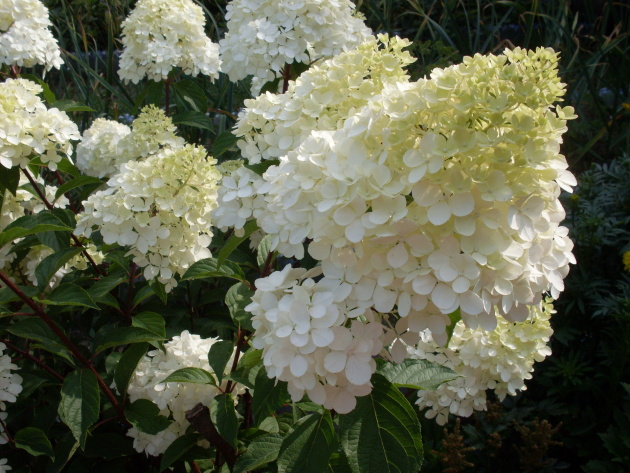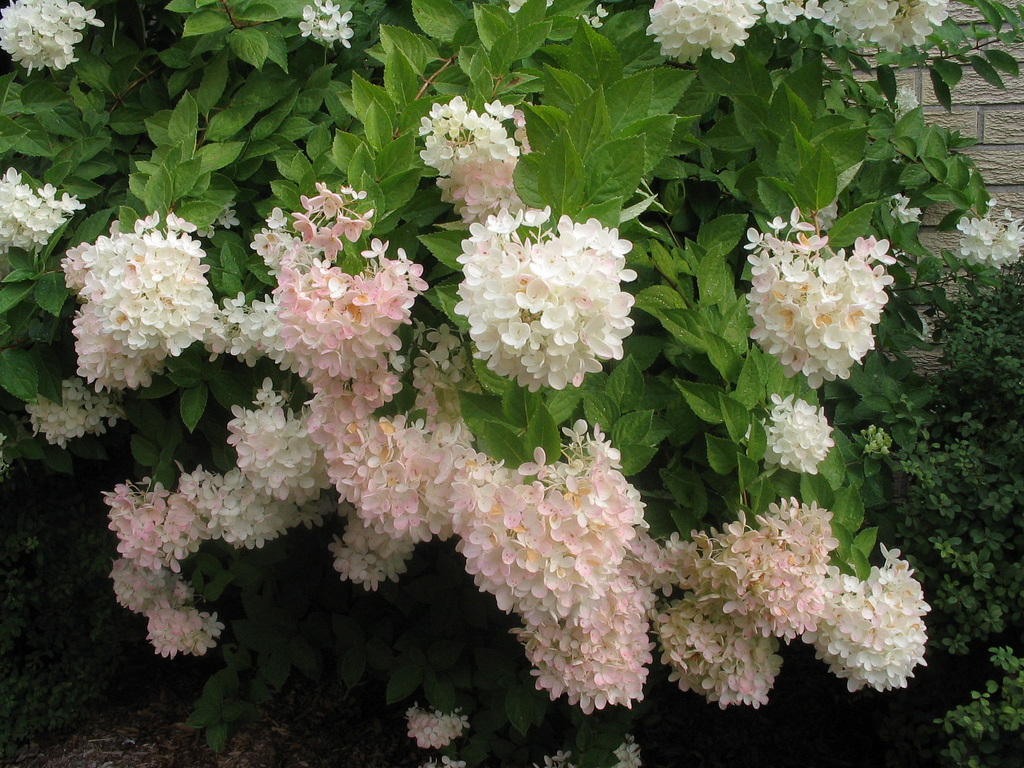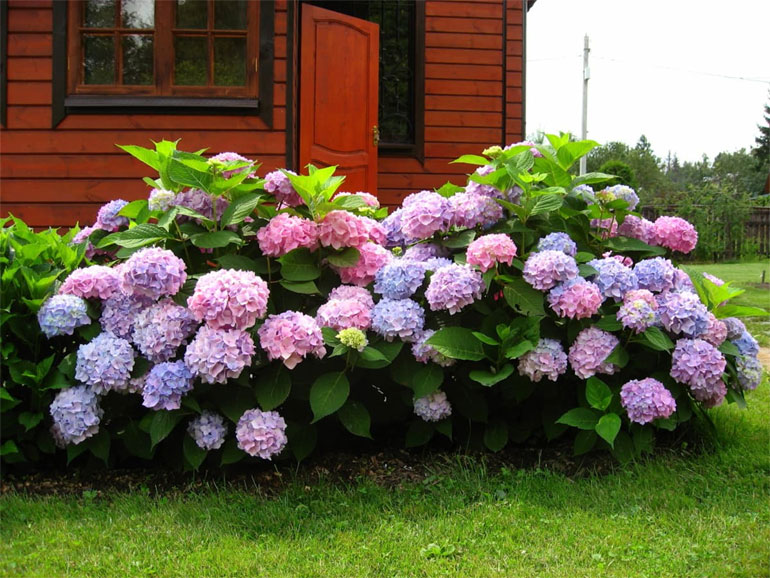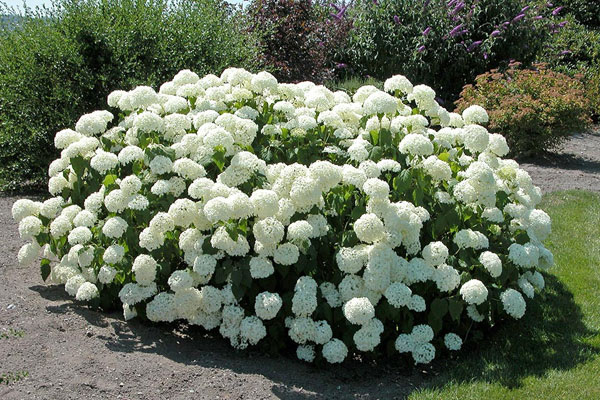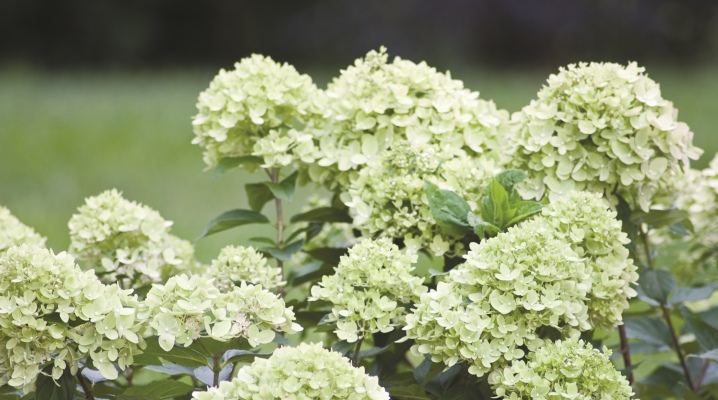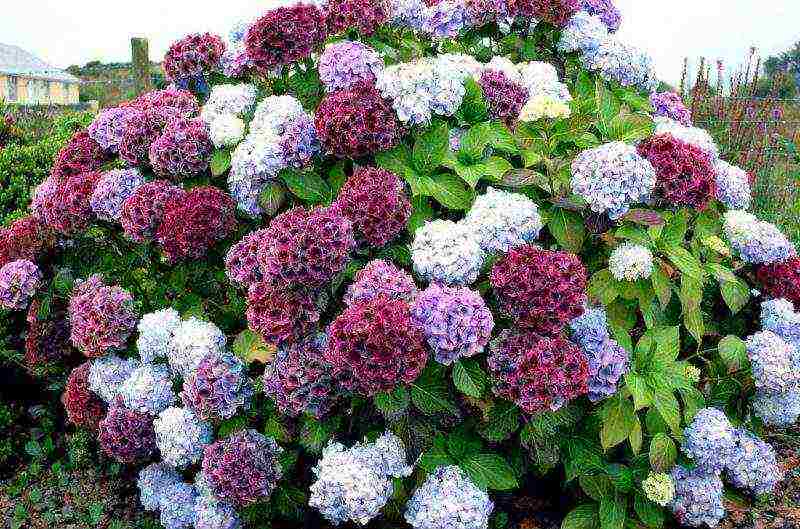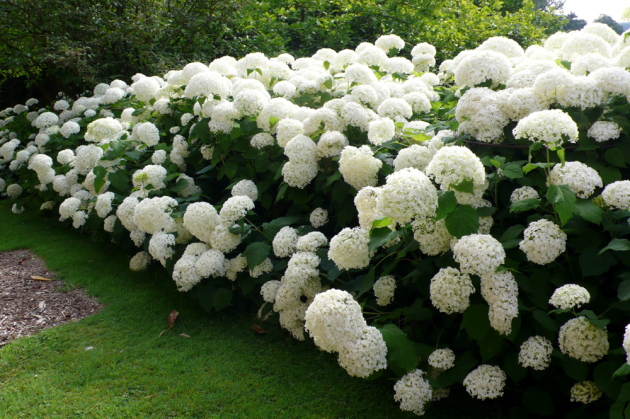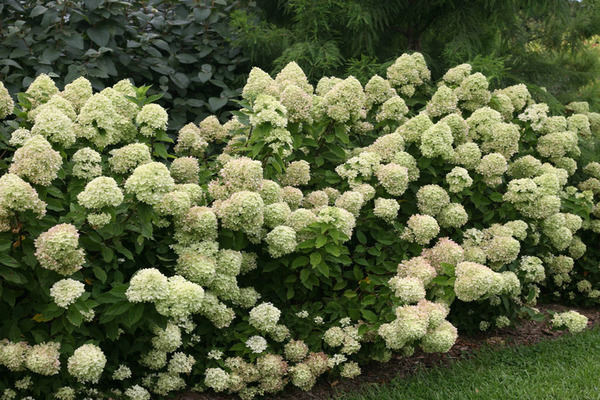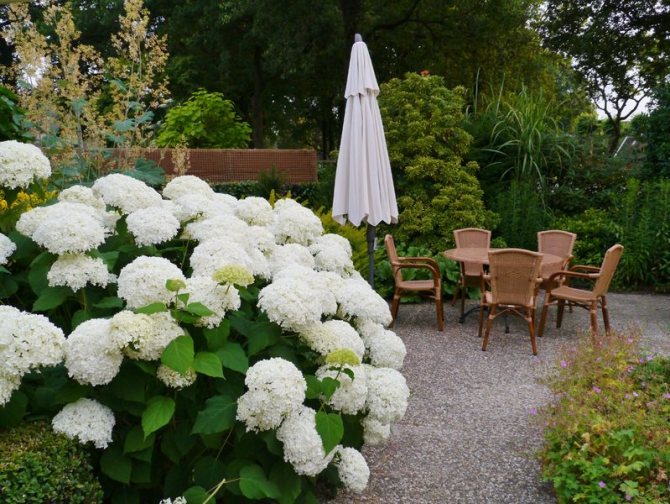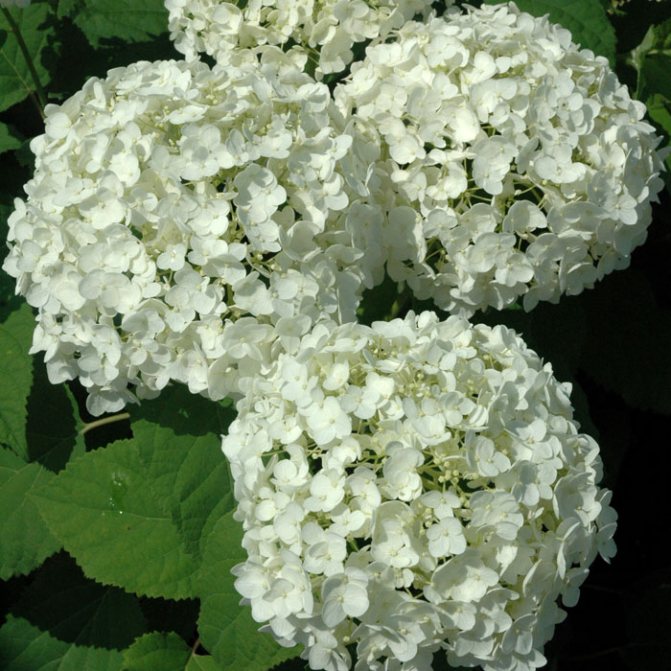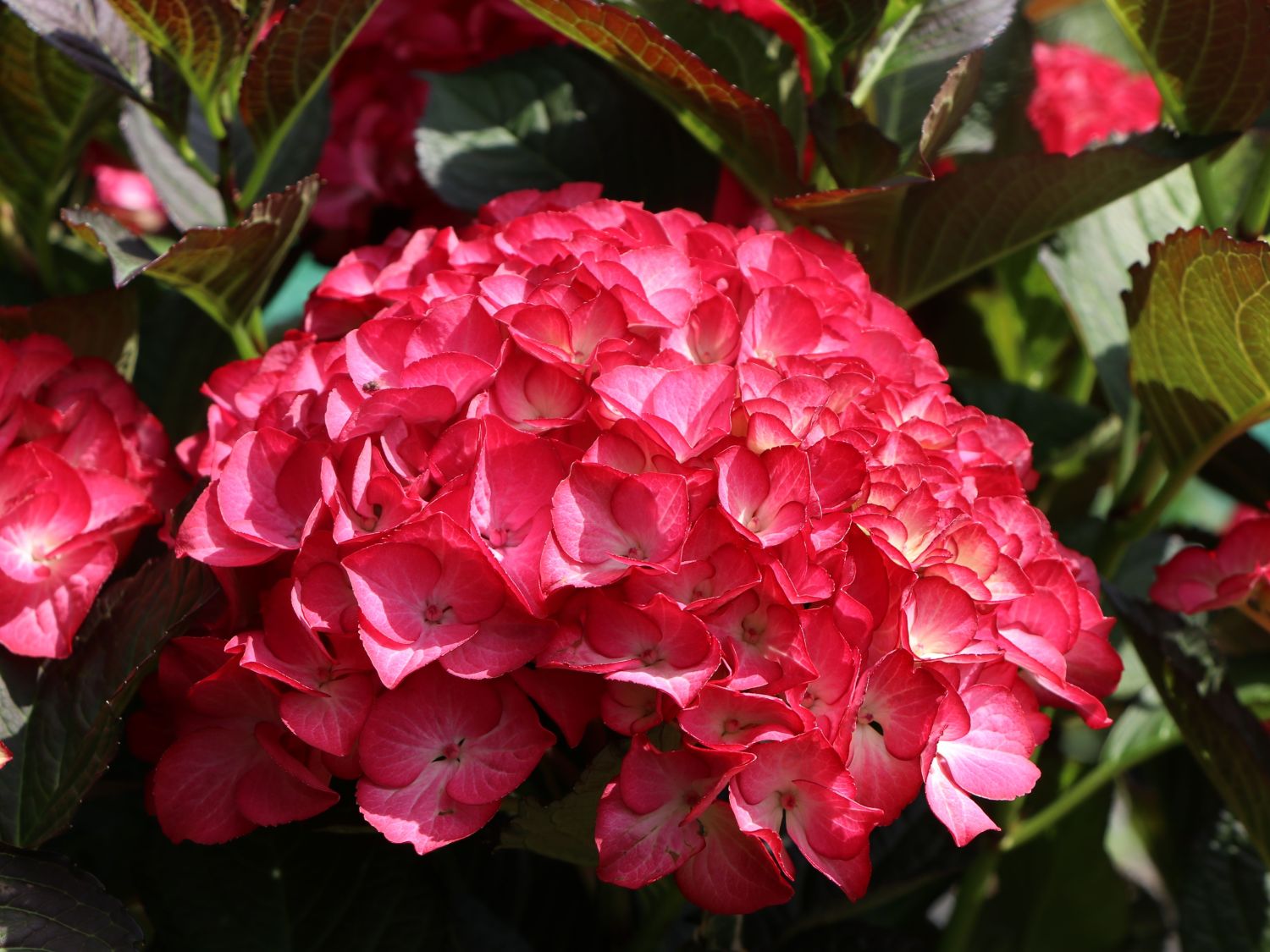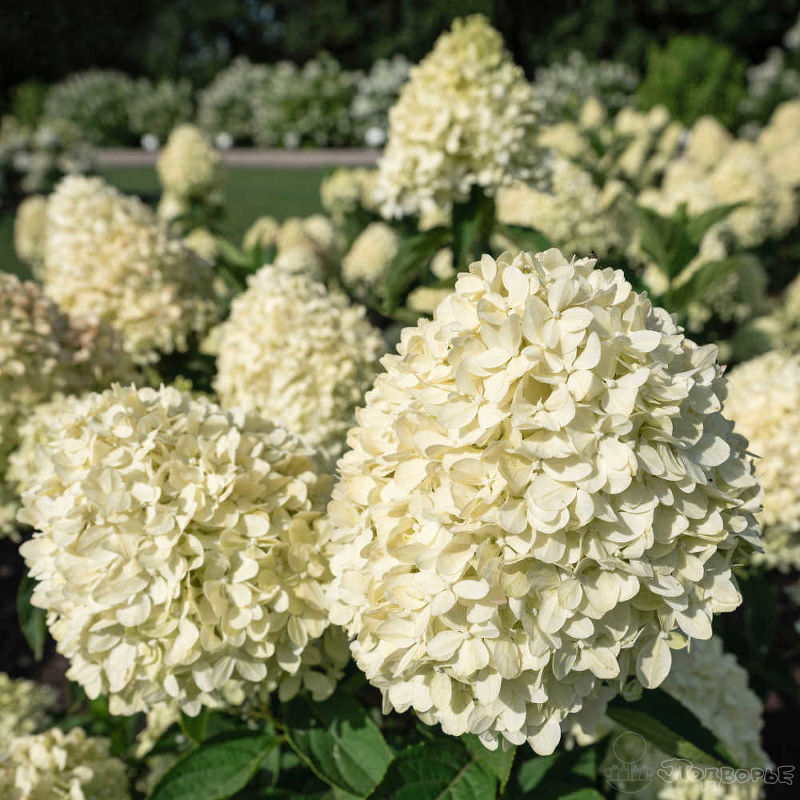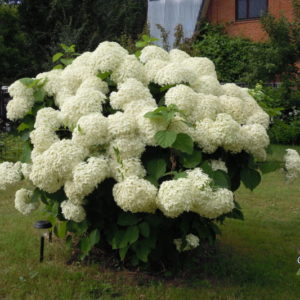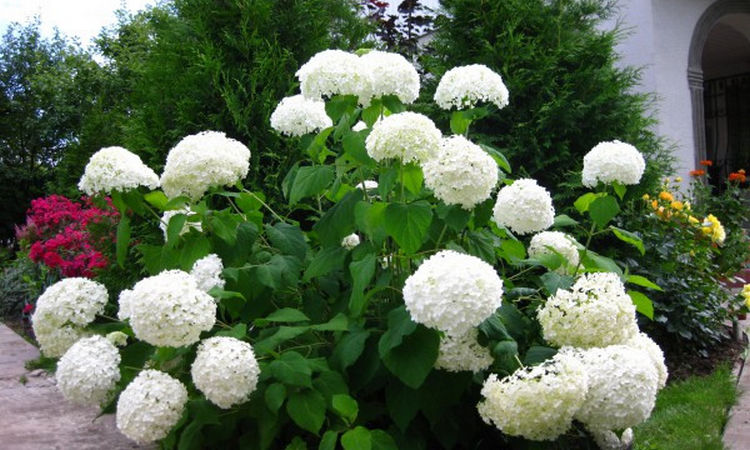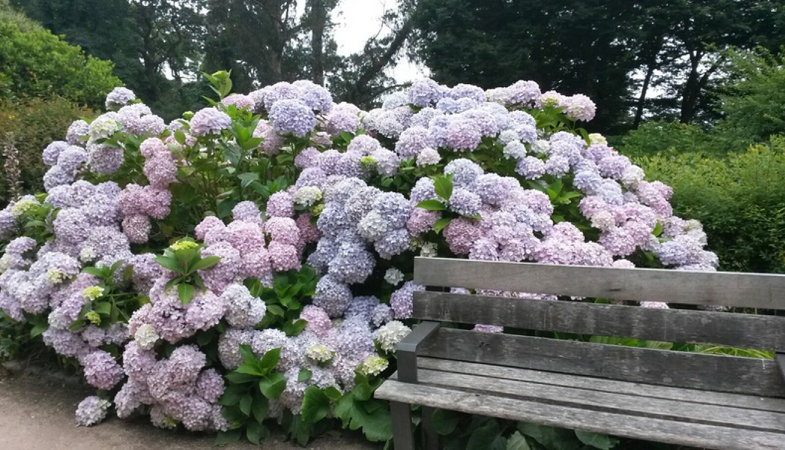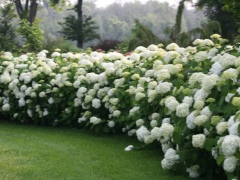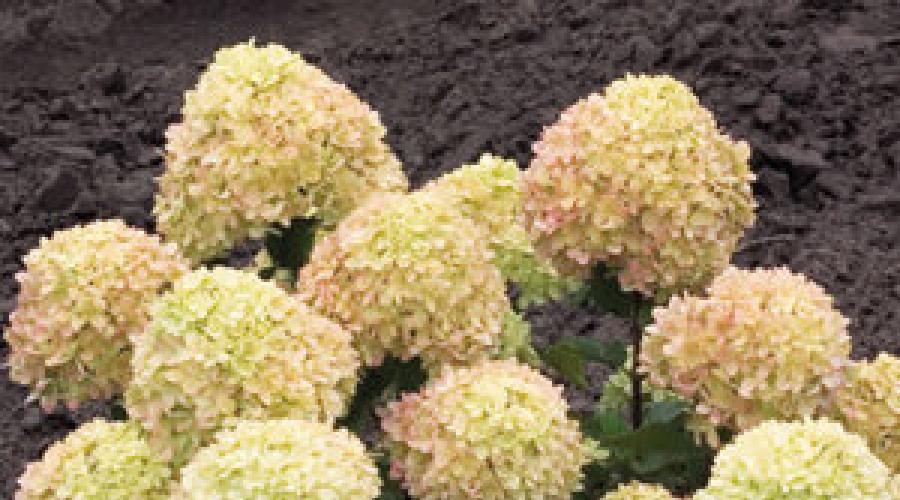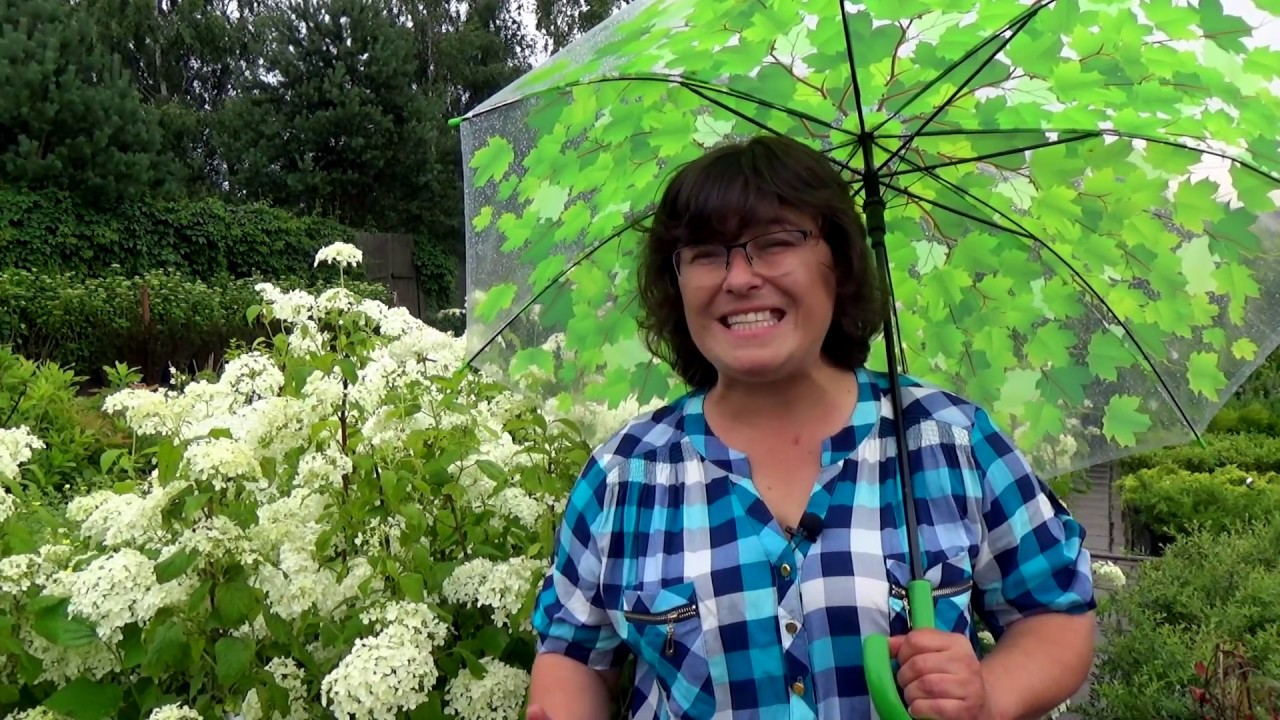Far from being a humble hydrangea
Back in the middle of the last (20th) century, country fashion made the panicle hydrangea a culture not just popular, but almost mandatory for any suburban area. It was used in the design of standard summer cottages so widely that it was almost impossible to imagine typical garden houses without flowering bushes of panicle hydrangea. But in the new millennium, the popularity of this type of hydrangea has declined and the plant has experienced almost a period of oblivion in recent years. Only the emergence of a trend in the design of easy-to-care gardens and an increased attention to the most hardy and undemanding plant species revived the former demand for panicle hydrangea. But this plant has something to boast about. The new career of panicle hydrangea that has begun is not at all associated with its modest role as a background shrub.
Hydrangea paniculata (Hydrangea paniculata) is one of the largest species of these shrubs, developing in the form of dense, powerful bushes or multi-stemmed trees up to 10 m high (most garden varieties are limited to a height of 1.5 m to 3 m). By nature, panicle hydrangea has a rather rounded crown. This shrub develops quickly, usually its annual growth is 25-30 cm. Leaves up to 12 cm long are oval or ovoid, with a weak edge on the upper surface and a strong edge along the veins on the lower side. The main decoration of the shrub is not light and bright foliage, but thick, wide pyramids of panicles, which in this hydrangea can reach 25 cm or more in length.
Inflorescences of paniculate hydrangeas, like other species of these shrubs, consist of two types of flowers: small fruiting ones are practically imperceptible, while large sterile flowers provide all the beauty of the inflorescences. In different varieties, the ratio of the two types of flowers and the density of their arrangement are very different, which provides a wide variety in the structure of panicles. In varieties with dominant sterile flowers, dense pyramids or brushes of panicle hydrangea in many ways resemble the usual favorite caps of large-leaved hydrangeas. But there are also varieties with more graceful lace panicles, in which a greater number of fruiting flowers provides an almost airy translucent structure of the inflorescence. Infertile flowers consist of 4 petals, their diameter is most often limited to 2.5 cm.
The flowering of panicle hydrangeas begins at the age of 4 - 5 years. After flowering, fruit pods up to 3 mm long are tied, beautifully cracking at the top. The seeds are very small. Seed ripening occurs in October, in the middle lane you can wait for it very rarely, and even then not for all varieties, even with very favorable weather conditions.
Most varieties of panicle hydrangea have a very pleasant aroma. Their scent is especially felt when planted in large groups. Without exception, all varieties of hydrangea paniculata are honey plants.
Hydrangea paniculata (Hydrangea paniculata). Deborah Silver
Garden hydrangea: photos, types, varieties
Most hydrangea species are shrubs, but there are vines and small trees. All of them have beautiful large or small leaves, and flowers collected in paniculate or corymbose inflorescences. All inflorescences are located at the tops of the shoots and have sterile or fertile flowers. Most often, their color can be white, pink or blue.
Among them, only tree hydrangea and paniculate hydrangea are grown as perennial plants in the gardens of central Russia.
Hydrangea tree - photo
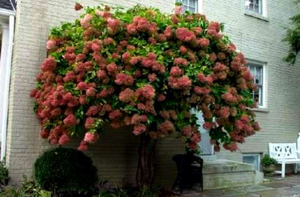 The shrub, which grows up to one and a half meters in height, has large oval leaves, the length of which reaches 20 cm. Slightly pubescent leaf plates are distinguished by a heart-shaped notch at the base and jagged edges along the edges. From above they are green, and from below they have a bluish tint.Large sterile and small fertile flowers are collected in corymbose inflorescences, which bloom in the first half of July.
The shrub, which grows up to one and a half meters in height, has large oval leaves, the length of which reaches 20 cm. Slightly pubescent leaf plates are distinguished by a heart-shaped notch at the base and jagged edges along the edges. From above they are green, and from below they have a bluish tint.Large sterile and small fertile flowers are collected in corymbose inflorescences, which bloom in the first half of July.
The following varieties of tree hydrangea are most suitable for planting in the garden:
- Variety "White House" is a bush with a height of one to one and a half meters. At the ends of its shoots, large thyroid inflorescences are formed, consisting of snow-white sterile and creamy white fertile flowers.
- InvincibelSpirit grows up to 0.9-1.2 m. Its large inflorescences consist of sterile flowers. At first, they have a bright pink color, and over time they fade to light pink.
- Variety "Incrediboll" is a bush that reaches a height of 1.2-1.5 m, and has large spherical white inflorescences.
- Heis Starburst is a short bush with slender shoots that can break under the weight of large inflorescences. The inflorescences, consisting of double flowers, reach 25 cm in diameter.
- The Annabelle variety blooms with white sterile flowers, which form large inflorescences with a diameter of up to 25 cm.
Hydrangea paniculata - varieties, photo
Panicle hydrangea differs from tree hydrangea in inflorescences, which consist of large sterile and small fertile flowers, and grow up to 20-25 cm in length. During flowering, they can change color. For the first time days, the petals of flowers are white, after a while they acquire a pink tint, and by the end of flowering they turn green. Large leaves of paniculate species are distinguished by an ovoid or elliptical shape. Below they are heavily pubescent, and slightly above.
Garden varieties bloom from June to July, and bloom for a long time. Among them are:
- Variety "Vanilla Freise" grows up to two meters and is distinguished by a conical inflorescence on which flowers of a strawberry-pink color are densely located.
- The Phantom variety is a bush with a spreading crown, growing up to 2.5 m. Its pyramidal large inflorescences have a creamy white hue at the beginning of flowering, and turn pink by autumn.
- Variety "Pinky-Winky" is a bush up to 1.8 m high, on the shoots of which openwork conical purple-pink inflorescences are formed.
- The Limelight variety is distinguished by dense greenish inflorescences, which turn pink by the end of the season.
- The variety "Grandiflora" has been known among gardeners for a long time for its dense inflorescences, which consist of sterile flowers.
- The Vims Red variety is a beautifully shaped bush that reaches a height of 2 m. From the ground to the very top, it is covered with delicate inflorescences that bloom in June. At first they have a white color, then they become deep pink, and after a while - burgundy-red.
- The variety "White Lady" is distinguished by white inflorescences, which consist of a few flowers with jagged edges. Grows up to two meters.
- The Kiushu variety is a bush with delicate inflorescences and erect shoots up to 2.5 m high.
- The "Great Star" variety is a plant up to two meters in height. Its shoots are strewn with inflorescences, which consist of white flowers with petals in the shape of a "propeller".
- Earley Sensation is distinguished by its early flowering and dark purple shoots. On its openwork, wide-conical inflorescences, purple-pink flowers are formed.
- The variety "Diamond Rouge" is a bush up to 1.8 m high. Its dense, large inflorescences very quickly acquire a red hue.
- The Daruma variety is a low-growing shrub with reddish leaves and small openwork inflorescences. The dark pink flowers become reddish over time.
Landing
Plants are planted in early spring. In some regions where winters are not accompanied by a severe cold snap, the material sprouted at home is allowed to be planted in open ground in the fall, choosing an already permanent place for culture.
When placing hydrangeas, it is worth remembering that all of its varieties belong to light-loving crops.For proper growth and development, the flower will need regular contact with direct sunlight. An alternative can be areas with diffused light or partial shading, which are suitable for weaving varieties, groundcover and tree species.

It is recommended to root flowering crops in loose soil, rich in composition in organic fertilizers. As for acidity, priority is given to earth with a neutral or slightly acidic pH.
With regard to suitable crops for growing nearby, it is worth avoiding placing hydrangeas next to plants that have a shallow root system, as crops will compete as they develop in terms of extracting water and nutrients from the soil.
The hydrangea planting algorithm includes several points.
- To root the seedlings, you need to make a hole. The optimal sizes of the planting pit will be values that are 2 times the size of the plant roots.
- Planting hydrangeas in open ground should be carried out together with an earthen clod from a container or pot in which the plant grew at home or was purchased.
- After placing the culture in the hole, it is sprinkled with soil, tamped. Organic complex fertilizers can be applied to the bottom, the use of peat is encouraged. It is best to leave part of the root system above the ground.
- The final stage of planting will be the shelter of the root system; for this, the flower is advised to mulch with sawdust.
Hydrangea in the landscape design of a garden and a summer cottage
Hydrangea, due to its unpretentiousness, richness of shapes and colors, has become popular in landscape design. And what other flower can you change the color on your own according to your mood or the palette of the site design? It is often found in mixborders, rock gardens, decorative compositions and as a hedge. Hydrangea is suitable for both group and single plantings. Versatility, beauty, long flowering period, ease of maintenance - these are the very qualities for which landscape designers appreciate this flower.

Hydrangea and design styles
Hydrangea is versatile. It can be integrated into any stylistic solution. It is possible to spoil the plot with flowers only if they have an untidy, unkempt appearance. Hydrangea goes well with the Japanese ethnic style. In a minimalistic design, she has always been a welcome guest. Lush inflorescences will complement the variegation of the garden, decorated in country, modern, naturgarden and ethnic styles. The last group of directions deserves special attention. Hydrangea organically blends into the chaotic, lush plantings of the Moorish style, and into the restrained, strict English compositional ensembles.

Creating a flower bed with hydrangea
Low, neatly trimmed hydrangea bushes are suitable for neat flower beds around the house and along paths. Tall plantings will become the center of a free composition, rabatka, mixborder or live fencing tape. Since hydrangea is a perennial, the flowerbed of continuous flowering must be protected with low-growing conifers, which will highlight the colorfulness of the "core" of the composition. The place for the flower garden is cleaned of weeds, dug up and fertilized. You need to combine the components of the composition in shade and height. If the flower bed is adjacent to a fence or other obstacle, that is, it is one-sided, then tall plants are first planted, gradually moving to those that are lower. If the flower garden is located in the center (for example, between garden paths), then tall flowers are located in the center.

Difficult choice among many varieties
Choosing a large-leaved hydrangea is not easy at all. Not only have many varieties of macrophile hydrangea been bred for open ground, but also for growing in pots. Problems with winter hardiness and acclimatization sometimes arise with imported varieties.For a good wintering, even with shelter, varieties adapted to our climate are suitable. The frost resistance of the plant declared by the seller is very important. Hydrangeas brought from Europe can be capricious. We invite you to get acquainted with the macrophiles most suitable for the climate of the middle zone.
Let's start with a charming terry hydrangea variety that changes its bright pink color to reddish green - "papillon". The bush of this plant is very compact, the leaves are dark green. Hydrangea has dense, large inflorescences. The double flowers themselves look like small roses.
A compact meter-long bush grows a remontant hydrangea "blueberry cheesecake". It is much larger in width than in height. This purple beauty blooms in July, but the inflorescences last until November. The leaves are dark green in summer, and by autumn they begin to turn red.
A spreading variety of hydrangia, reaching a height of up to one and a half meters, is the “four colors” variety. It has very large inflorescences and rich green leaves with original specks. The flower has this name because the inflorescences on one bush can be of four shades: white, pink, lilac, blue.
A very beautiful ruffled remontant variety with a dark pink tint and purple tints is the “spike” variety. Its flowers have a corrugated wavy edge of petals. As inflorescences in the form of a very large sphere, the flowers of this variety are so tightly adjacent to each other that they cannot fully bloom. The leaves at the "spike" are very bright, and the flowers are white-blue-green.
Another hybrid variety of hydrangea is the "green shade". It is distinguished by a wavy and jagged edge of bright pink petals with a yellow-green center. This variety grows in a compact dense bush of one meter height. Inflorescences differ in that they have an openwork flowering. The bushes have a solemn and noble appearance.
One and a half meter bright variety with inflorescences in the form of spherical caps - "Gerda Steiniger". Its inflorescences have a rich crimson-lilac color. By the end of summer, the color of the flowers changes. The bush is perfectly shaped due to its straight shoots. If this hydrangea freezes a little in winter, then in spring it quickly recovers.
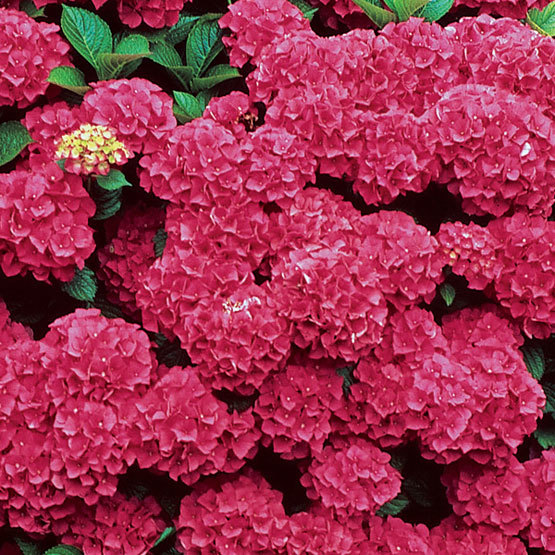
Erect tough shoots and stunningly beautiful variegated foliage are observed in the tricolor variety. The flowers of this plant are white with yellow and pink spots. The leaves are muted green
It is important to note that the Tricolor variety does not tolerate alkaline soil
Many gardeners admire the legendary remontant variety, considered the benchmark for growing in the middle lane - "endless summer". The flowers can be either pale pink or blue. The inflorescence balls can reach up to 20 cm in diameter. The straight stems of this plant are quite well adapted to harsh winters.
The legendary variety, which is distinguished by the most delicate, watercolor, pastel-pale color of the inflorescences, is the “brilliant bride”. Light white flowers of this variety have a semi-double shape, as well as pink, blue, lilac color with specks in the center. It is an early flowering plant that is disease resistant.
In addition to the above varieties, you need to add other frost-resistant varieties: Hamburg, Lanart White, Admiration, Early Sensation, All Summer. This is a rather incomplete list of garden hydrangeas. We must also remember the following varieties: "mini-penny", "bouquet of roses", "love", "passion", "forever", "romance".
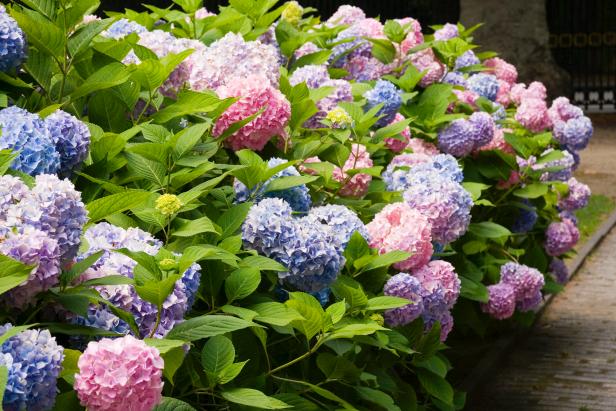
Hydrangea care
Caring for hydrangea is easy
In order for the flower to please with lush flowering, it is important to adhere to certain rules of care.
Watering
Hydrangea is very fond of wet soil. The plant must be watered every day, 4-5 liters for each bush. Hard water should not be used for irrigation; it must be filtered or settled for five days. In a period of intense heat, the amount of water should be increased to 10-12 liters for one bush.
Loosening, weeding and mulching
The land around the trunk circle and between the bushes must be weeded, loosened and mulched in a timely manner. This should be done at least 2 times a month.
Loosening and weeding helps to retain moisture and oxygenate the roots.
It is worth considering! The roots of the hydrangea are shallow, so loosening is best done to a depth of no more than 3-4 centimeters.
Mulching will help keep the soil moist and keep weeds out. Pine needles, rotted peat or sawdust can be used as mulch.
Top dressing
Hydrangeas need top dressing, they are applied at intervals of every 14 days. Organic matter (liquid manure and bird droppings) and mineral complexes for hydrangeas are used as fertilizers. These dressings are introduced alternately, so the plant will perceive them better.
Pruning
Pruning is done in early spring, just after all the snow has melted. On young bushes, all stems are cut to the level of 2-3 pairs of buds; on adult plants, one pair is left. After pruning, a new shoot will grow from each bud, at the top of which an inflorescence will appear. Also, remove all thin and weak branches, as well as stems that grow inside the bush. So, together with pruning, the bush is formed.
Note! If the plant has begun sap flow, it is better to transfer pruning until the leaves are completely blooming.
Pruning hydrangea
Transfer
It is better to transplant a bush every 5 years. They do it in the spring. If the plant is sick and grows poorly in the selected area, it must be transplanted urgently. The transplant is no different from the planting process.
Actions to be taken during the flowering period
This variety of hydrangea has very thin and fragile stems, which often break under the weight of large inflorescences. To prevent this from happening, it is necessary to tie up all the branches and large inflorescences to the support. Also, during the period of active growth and especially flowering, it is necessary to feed the plant with organic and mineral fertilizers.
In addition, it is important not to forget to remove all processes and lateral growth in a timely manner.
Bush care during dormancy
When the shrub has stopped blooming, it is necessary to update the layer of mulch around the trunk, thereby allowing the plant to be nourished and well prepared for winter. It is also necessary to remove all inflorescences and dry leaves. When the plant has shed all the leaves, it is worth cutting off all the tassels and shortening the stems in half.
Shelter hydrangea for the winter
Preparing for winter
Despite the good frost resistance, the root system of the plant is not very deep, so it is necessary to prepare the bushes well for wintering so that they do not freeze out during the cold season. To do this, all the bushes are well spud and cover the trunk circle with a thick layer of mulch. Next, you need to bend all the branches to the ground and cover with spunbond. The space between the branches can be filled with dry leaves.
If you adhere to all the recommendations for planting, cultivation and care, the Sunday Fries variety will be a wonderful decoration for any garden for a long time.

